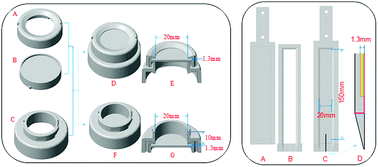New holder configurations for use in the diffusive gradients in thin films (DGT) technique
Abstract
This study reports two new holder configurations that can be used in the diffusive gradients in thin films (DGT) technique, including a dual-mode holder and a new flat-type holder. The dual-mode holder can be assembled as a piston type, similar to the existing one for deployments in solution/water. It can also be assembled to form a hollow cylinder (open cavity) with 10 mm depth and 20 mm diameter, in which the soil paste is placed in contact with the exposed surface of the DGT unit at the bottom of the open cavity. Tests of the open cavity-type holder showed good agreement with the existing press-type holder in measurements of P, As, Cd and Pb in soils. However, the variability in measurements has been significantly reduced in the new holder configuration by 42%. This is due to the elimination of errors caused by manual pressing of the soil paste in the existing holder configuration. Moreover, the new flat-type holder used for deployment in sediments does not have the raised bottom edge design of the existing one, which allows its exposure surface to be on the same plane as the bottom of the holder. Tests of the new flat-type holder loaded with exposed sulfide binding gel showed that the penetration depths of dissolved sulfide and sulfide-enriched sands in sediments were only 33% and 20% of those obtained using the existing holder. The DGT measurements with the new holder resulted in low-concentration sulfide distribution at a much shallower depth (2.5 mm vs. 6 mm) by preventing the seepage of oxic overlying water into the sediment. The new holder usage also caused the disappearance of an abnormal sulfide-enriched slide in the top sediment layer, which likely resulted from the sulfide-enriched fecal pellets being pushed from the sediment surface into the top layer by the existing holder. These results demonstrate that the probe insertion-induced mobilization of dissolved and particulate substances has been reduced greatly with the new holder. Thus, the use of the new holder configurations can help to obtain much more accurate DGT measurements in soils and sediments. To the best of our knowledge, this is the first report describing a significant modification of the DGT holder configurations.



 Please wait while we load your content...
Please wait while we load your content...